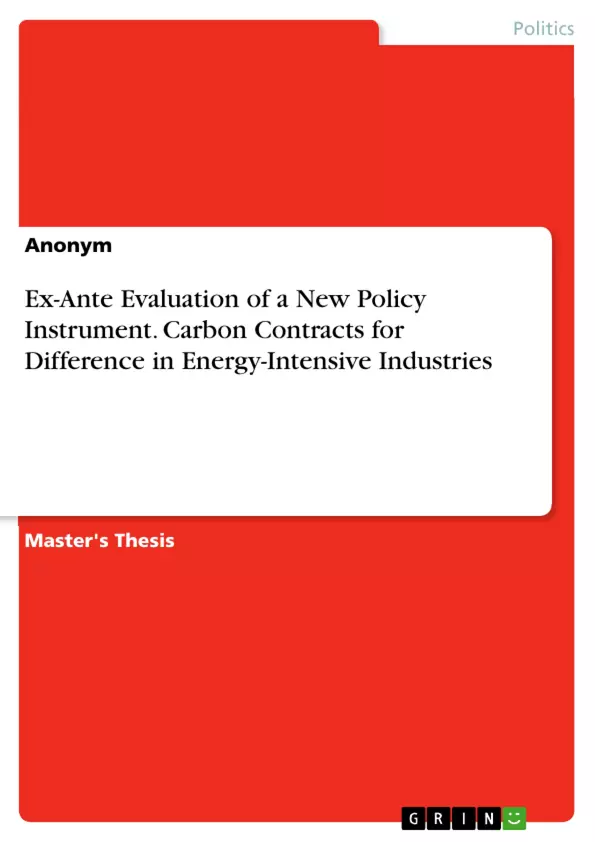This thesis aims to clarify how feasible Carbon Contracts for Difference (CCfDs) are and how they compare to other policy instruments. It further explores what design elements the policy instrument needs to contain to be effective. To answer these questions, the feasibility of CCfDs was analysed through industry and policy publications using evaluation criteria and subsequently the most important design elements were identified and examined.
The introduction of climate-friendly technologies in energy-intensive industries requires significant investments. These investments are often withheld due to competitive disadvantages and carbon price risks, thus preventing the progress of industry. As a remedy, CCfDs between the state and companies should reduce risks and thus create incentives for investment.
Inhaltsverzeichnis (Table of Contents)
- Abstract
- Kurzzusammenfassung
- Table of Contents
- List of Abbreviations
- List of Tables
- List of Figures
- Introduction
- Introductory remarks
- Research problem
- Research objectives and research question
- Significance and limitations
- Structural outline
- Background
- Decarbonisation of the energy-intensive industry
- Instruments for the transformation of industry
- Carbon contracts for difference
- Method
- Existing complementary policies and proposals
- Carbon border adjustment mechanism
- Climate contributions
- Carbon clubs approach
- Research design
- Data collection, data analyses and limitations
- Existing complementary policies and proposals
- Ex-ante evaluation of instruments
- Criteria for the policy evaluation
- Political and diplomatic feasibility
- Sustainability and policy longevity
- Administrative feasibility
- Legal feasibility
- Technical feasibility
- Evaluation
- CCfDs
- Political and diplomatic feasibility
- Sustainability and policy longevity
- Legal Feasibility
- Administrative feasibility
- Technical feasibility
- CBAM
- Political and diplomatic feasibility
- Sustainability and policy longevity
- Legal Feasibility
- Administrative feasibility
- Technical feasibility
- Climate Contributions
- Political and diplomatic feasibility
- Sustainability and policy longevity
- Legal Feasibility
- Administrative feasibility
- Technical feasibility
- Carbon Clubs
- Political and diplomatic feasibility
- Sustainability and policy longevity
- Administrative feasibility
- Legal Feasibility
- Technical feasibility
- Overview of the evaluation
- CCfDs
- Instrument design
- Possible variants of the instrument design
- Awarding the contracts
- Allocation mechanism
- Technological and sectoral scope
- Duration
- Legal practicability
- Financing of the instrument
- Hedging other input risks
- Interaction with other kinds of instruments and support schemes
- Discussion and conclusions
- Evaluation
Zielsetzung und Themenschwerpunkte (Objectives and Key Themes)
This thesis aims to analyze the feasibility of Carbon Contracts for Difference (CCfDs) as a policy instrument to incentivize investments in climate-friendly technologies within energy-intensive industries. The research examines how CCfDs compare to other policy instruments and explores key design elements needed for effective implementation. This study aims to guide policy recommendations for the swift introduction of CCfDs, taking into account the identified design elements.
- Feasibility and effectiveness of CCfDs compared to other policy instruments
- Key design elements for effective CCfD implementation
- Analysis of relevant policy instruments, including CBAM, climate contributions, and climate clubs
- Evaluation criteria for assessing the feasibility and effectiveness of policy instruments
- Recommendations for swift introduction of CCfDs, considering identified design elements
Zusammenfassung der Kapitel (Chapter Summaries)
- Introduction: The chapter introduces the research problem and objectives, outlining the significance and limitations of the study. It also presents the structural outline of the thesis.
- Background: This chapter provides context by discussing the need for decarbonization in energy-intensive industries and explores various instruments used for industrial transformation, focusing on the concept of Carbon Contracts for Difference.
- Method: The chapter describes the methodology employed, including the identification of relevant complementary policies and proposals such as CBAM, climate contributions, and climate clubs. It also details the research design and data collection processes.
- Ex-ante Evaluation of Instruments: This chapter presents an ex-ante evaluation of different policy instruments, employing a set of criteria to assess their political, diplomatic, sustainability, administrative, legal, and technical feasibility. The evaluation considers CCfDs, CBAM, climate contributions, and climate clubs.
- Instrument Design: This chapter delves into the design of the CCfD instrument, exploring various aspects such as geographical scope, price of the contract, awarding mechanisms, technological and sectoral scope, duration, legal practicability, financing, hedging input risks, and interaction with other instruments and support schemes.
Schlüsselwörter (Keywords)
The primary focus of this thesis lies in the evaluation of Carbon Contracts for Difference (CCfDs) as a policy instrument for incentivizing climate-friendly technologies in energy-intensive industries. Key themes and concepts explored in this work include decarbonization, energy transition, climate-friendly technologies, feasibility analysis, policy instruments, CBAM, climate contributions, climate clubs, and the assessment of political, diplomatic, sustainability, administrative, legal, and technical aspects of these instruments.
- Criteria for the policy evaluation
- Arbeit zitieren
- Anonym (Autor:in), 2022, Ex-Ante Evaluation of a New Policy Instrument. Carbon Contracts for Difference in Energy-Intensive Industries, München, GRIN Verlag, https://www.grin.com/document/1337486



